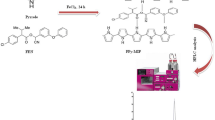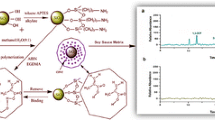Abstract
A new selective molecularly imprinted polymer has been prepared and used for extraction in on-line SPE-HPLC to achieve the selective determination of citrinin. Four different imprinted polymers varying in combinations of components were prepared by bulk polymerization and evaluated in terms of binding capacity and selectivity. Imprinted polymer prepared from a mixture comprising 1-hydoxy-2-naphtoic acid as the template molecule, acrylamide as the structural monomer, ethylene dimethacrylate as the cross-linker (in a molar ratio of 1:4:16), and acetonitrile as the porogenic solvent exhibited the best properties. The selectivity of this sorbent was confirmed by comparison with the non-imprinted counterpart prepared using the same polymerization carried out in the absence of template. Imprinted polymer was packed in a 20 × 3 mm i.d. steel cartridge and coupled to the on-line SPE-HPLC system through a six-port switching valve. The method for determination of citrinin including the on-line extraction step was then developed and validated. The sample in the form of methanolic extract was loaded, cleaned, and preconcentrated in the imprinted SPE cartridge. Subsequent separation of citrinin from residual interferences was achieved using the analytical column Kinetex Biphenyl 100 × 4.6 mm i.d., 5 μm particle size, and fluorescence detection (Ex 335, Em 500 nm). The total analysis time was only 9.50 min. Our fully validated method was also applied to analysis of food supplements based on red yeast rice extracts, the control of which is implemented in European legislation. Only minor yet acceptable contamination was found in tested samples.







Similar content being viewed by others
References
Halbert SC, et al. Tolerability of red yeast rice (2,400 mg twice daily) versus pravastatin (20 mg twice daily) in patients with previous statin intolerance. Am J Cardiol. 2010;105:198–204.
Nguyen T, Karl M, Santini A. Red yeast rice. Foods. 2017;6:19.
Childress L, Gay A, Zargar A, Ito MK. Reviews of red yeast rice content and current Food and Drug Administration oversight. J Clin Lipidol. 2013;7:117–22.
Huiqin W, Shufen Z, Taifeng L, Dawei Z. Introduction and safety evaluation of citrinin in foods. J Food Nutr Sci. 2017;5:179–83.
Ostrý V, Malíř F, Ruprich J. Producers and important dietary sources of ochratoxin A and citrinin. Toxins. 2013;5:1574–86.
Phillips RD, Hayes AW, Berndt WO, Williams WL. Effects of citrinin on renal function and structure. Toxicology. 1980;16:123–37.
Flajs D, Peraica M. Toxicological properties of citrinin. Arh Hig Rada Toksikol. 2009;60:457–64.
Salah A, Bouaziz C, Prola A, Da Silva JP, Bacha H, Abid-Essefi S, et al. Citrinin induces apoptosis in human HCT116 colon cancer cells through endoplasmic reticulum stress. J Toxicol Environ Health A. 2017;80:1230–41.
Wu Y, Zhang N, Li Y, Zhao L, Yang M, Jin Y, et al. Citrinin exposure affects oocyte maturation and embryo development by inducing oxidative stress-mediated apoptosis. Oncotarget. 2017;8:34525–33.
Ribeiro SMR, Chagas GM, Campello AP, Kluppel MLW. Mechanism of citrinin-induced dysfunction of mitochondria. V. Effect on the homeostasis of the reactive oxygen species. Cell Biochem Funct. 1998;15:203–9.
Johannessen LN, Nilsen AM, Løvik M. Mycotoxin-induced depletion of intracellular glutathione and altered cytokine production in the human alveolar epithelial cell line A549. Toxicol Lett. 2007;168:103–12.
Maté G, Gazdag Z, Mike N, Papp G, Pócsi I, Pesti M. Regulation of oxidative stress-induced cytotoxic processes of citrinin in the fission yeast Schizosaccharomyces pombe. Toxicon. 2014;90:155–66.
de Oliveira Filho JWG, et al. A comprehensive review on biological properties of citrinin. Food Chem Toxicol. 2017;110:130–41.
Trivedi AB, Hirota M, Doi E, Kitabatake N. Formation of a new toxic compound, citrinin H1, from citrinin on mild heating in water. J Chem Soc Perkin Trans. 1993;1:2167–71.
European Commission. Commission Regulation (EU) No. 212/2014 amending Regulation (EC) 1881/2006 as regards maximum levels of the contaminant citrinin in food supplements based on rice fermented with red yeast Monascus purpureus. Off J Eur Union. 2014;L67:3–4.
Poór M, Matisz G, Kunsági-Máté S, Derdák D, Szente L, Lemli B. Fluorescence spectroscopic investigation of the interaction of citrinin with native and chemically modified cyclodextrins. J Lumin. 2016;172:23–8.
Vázquez BI, Fente C, Franco CM, Quinto E, Cepeda A, Prognon P. Rapid semi-quantitative fluorimetric determination of citrinin in fungal cultures isolated from cheese and cheese factories. Lett Appl Microbiol. 1997;24:397–400.
Ton X, Acha V, Bonomi P, Tse Sum Bui B, Haupt K. A disposable evanescent wave fiber optic sensor coated with a molecularly imprinted polymer as a selective fluorescence probe. Biosens Bioelectron. 2015;64:359–66.
Sadi BS, Bayat M, Tajik P, Hashemi SJ. Citrinin detection by intensified fluorescence signal of a FRET-based immunosensor using magnetic/silica core-shell. Saudi J Biol Sci. 2018;25:171–7.
Momar A, Sertić M, Nigović B. Development of a rapid LC/DAD/FLD/MSn method for the simultaneous determination of monacolins and citrinin in red fermented rice products. J Agric Food Chem. 2013;61:1072–80.
Huertas-Pérez JF, Arroyo-Manzanares N, García-Campaña AM, Gámiz-Gracia L. High-throughput determination of citrinin in rice by ultra-high-performance liquid-chromatography and fluorescence detection (UHPLC-FL). Food Addit Contam Part A Chem Anal Control Expo Risk Assess. 2015;32:1352–7.
Elaine M, Phyllis B, Dave L, Carol D. Analysis of citrinin in cereals, red yeast rice dietary supplement, and animal feed by immunoaffinity column cleanup and LC with fluorescence detection. J AOAC Int. 2016;99:1025–31.
Appell M, Jackson MA, Wang LC, Bosma WB. Determination of citrinin using molecularly imprinted solid phase extraction purification, HPLC separation, and fluorescence detection. J Liq Chromatogr Relat Technol. 2015;38:1815–9.
Liu Y, Wang H, Yao S, Zhu P. Detection of trace amounts of citrinin in dried orange peel by using an optimized extraction method coupled with ultra-performance liquid-chromatography-tandem mass spectrometry. Biomed Chromatogr. 2018. https://doi.org/10.1002/bmc.4237.
Ji X, Xu J, Wang X, Qi P, Wei W, Chen X, et al. Citrinin determination in red fermented rice products by optimized extraction method coupled to liquid chromatography tandem mass spectrometry (LC-MS/MS). J Food Sci. 2015;80:T1438–T144.
Wang M, Jiang N, Xian H, Wei D, Shi L, Feng X. A single-step solid phase extraction for the simultaneous determination of 8 mycotoxins in fruits by ultra-high performance liquid chromatography tandem mass spectrometry. J Chromatogr A. 2016;1429:22–9.
Nigović B, Sertić M, Mornar A. Simultaneous determination of lovastatin and citrinin in red yeast rice supplements by micellar electrokinetic capillary chromatography. Food Chem. 2013;138:531–8.
Wang W, Chen Q, Zhang X, Zhang H, Huang Q, Li D, et al. Comparison of extraction methods for analysis of citrinin in red fermented rice. Food Chem. 2014;157:408–12.
Appell M, Mueller A. Mycotoxin analysis using imprinted materials technology: recent developments. J AOAC Int. 2016;99:861–4.
Akyıldırım O, Kardaş F, Beytur M, Yüksek H, Atar N, Yola ML. Palladium nanoparticles functionalized graphene quantum dots with molecularly imprinted polymer for electrochemical analysis of citrinin. J Mol Liq. 2017;243:677–81.
Fang G, Liu G, Yang Y, Wang S. Quartz crystal microbalance sensor based on molecularly imprinted polymer membrane and three-dimensional Au nanoparticles@mesoporous carbon CMK-3 functional composite for ultrasensitive and specific determination of citrinin. Sensors Actuators B Chem. 2016;230:272–80.
Guo B, Wang S, Ren B, Li X, Qin F, Li J. Citrinin selective molecularly imprinted polymers for SPE. J Sep Sci. 2010;33:1156–60.
Urraca JL, Huertas-Pérez JF, Cazorla GA, Gracia-Mora J, García-Campaña AM, Moreno-Bondi MC. Development of magnetic molecularly imprinted polymers for selective extraction: determination of citrinin in rice samples by liquid chromatography with UV diode array detection. Anal Bioanal Chem. 2016;408:3033–42.
Campone L, Piccinelli AL, Celano R, Russo M, Valdés A, Ibáñez C, et al. A fully automated method for simultaneous determination of aflatoxins and ochratoxin A in dried fruits by pressurized liquid extraction and on-line solid-phase extraction cleanup coupled to ultra-high-pressure liquid chromatography-tandem mass spectrometry. Anal Bioanal Chem. 2015;407:2899–911.
Drzymala SS, Weiz S, Heinze J, Marten S, Prinz C, Zimathies A, et al. Automated solid-phase extraction coupled online with HPLC-FLD for the quantification of zearalenone in edible oil. Anal Bioanal Chem. 2015;407:3489–97.
Lhotská I, Šatínský D, Havlíková L, Solich P. A fully automated and fast method using direct sample injection combined with fused-core column on-line SPE-HPLC for determination of ochratoxin A and citrinin in lager beers. Anal Bioanal Chem. 2016;408:3319–29.
He C, Long Y, Pan J, Li K, Liu F. Application of molecularly imprinted polymers to solid-phase extraction of analytes from real samples. J Biochem Biophys Methods. 2007;70:133–50.
Vidal JC, Duato P, Bonel L, Castillo JR. Molecularly imprinted on-line solid-phase extraction coupled with fluorescence detection for the determination of ochratoxin A in wheat samples. Anal Lett. 2012;45:51–62.
Bjarnason B, Chimuka L, Ramström O. On-line solid-phase extraction of triazine herbicides using a molecularly imprinted polymer for selective sample enrichment. Anal Chem. 1999;71:2152–6.
Machyňáková A, Hroboňová K. Synthesis and evaluation of molecularly imprinted polymers as sorbents for selective extraction of coumarins. Chromatographia. 2017;80:1015–24.
Zhou J, He X, Li Y. An acrylamide-based molecularly imprinted polymer for the efficient recognition of optical amino acid hydantoins. Anal Commun. 1999;36:243–6.
Hartl A, Stenzel WR. Development of a method for the determination of citrinin in barley, rye and wheat by solid phase extraction on aminopropyl columns and HPLC-FLD. Mycotoxin Res. 2007;23:127–31.
Acknowledgements
Special thanks are given to P. Kejzlar and J. Hlavatá (Technical University of Liberec, Institute for Nanomaterials, Advanced Technology and Innovation, Department of the Preparation and Analysis of Nanostructures) for providing SEM scans.
Funding
This work was supported by the Charles University Grant Agency, project no. 726 316. I. Lhotská received a financial support from the project of specific research of Charles University, project no. SVV 260 412. A. Machyňáková and K. Hroboňová received a financial support from Slovak Research and Development Agency with contract no. APVV-15-0355. This work was also supported by the EFSA-CDN project (no. CZ.02.1.01/0.0/0.0/16_019/0000841) co-funded by ERDF.
Author information
Authors and Affiliations
Corresponding author
Ethics declarations
Conflict of interest
The authors declare that they have no conflict of interest.
Additional information
Publisher’s note
Springer Nature remains neutral with regard to jurisdictional claims in published maps and institutional affiliations.
Electronic supplementary material
ESM 1
(PDF 359 kb)
Rights and permissions
About this article
Cite this article
Lhotská, I., Kholová, A., Machyňáková, A. et al. Preparation of citrinin-selective molecularly imprinted polymer and its use for on-line solid-phase extraction coupled to liquid chromatography. Anal Bioanal Chem 411, 2395–2404 (2019). https://doi.org/10.1007/s00216-019-01682-9
Received:
Revised:
Accepted:
Published:
Issue Date:
DOI: https://doi.org/10.1007/s00216-019-01682-9




